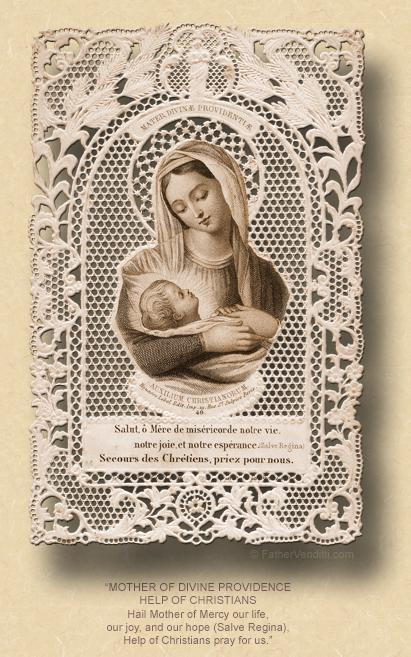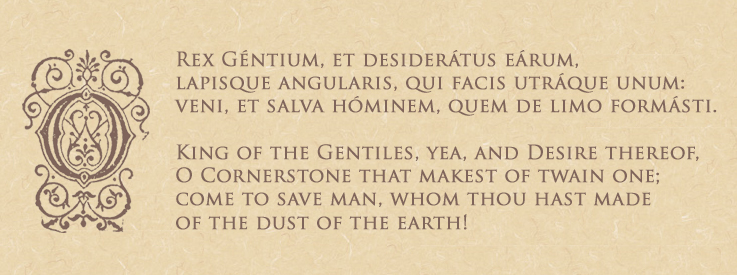Magnificat!
The Sixth Day of the Greater Antiphons.*
Lessons from the feria, according to the ordinary form of the Roman Rite:
• I Samuel 1: 24-28.
• [Responsorial] I Samuel 2: 1, 4-8.
• Luke 1: 46-56.
Ember Saturday of Advent; and, the Sixth Day of the Greater Antiphons.**
Lessons from the feria, according to the ordinary form of the Roman Rite:
• Isaiah 19: 20-22.
• [Gradual] Psalm 18: 7, 2.
• Isaiah 35: 1-7.
• [Gradual] Psalm 18: 6-7.
• Isaiah 40: 9-11.
• [Gradual] Psalm 79: 20, 3.
• Isaiah 45: 1-8.
• [Gradual] Psalm 79: 3, 2.
• Daniel 3: 47-51.
• [Hymn] Daniel 3: 52-56.
• II Thessalonians 2: 1-8.
• [Tract] Psalm 79: 2-3.
• Luke 3: 1-6.
FatherVenditti.com
|
 8:57 PM 12/21/2018 — The Magnificat, which makes up the totality of our Gospel lesson on this Sixth Day of the Greater Antiphons, is well familiar to anyone who offers one of the many forms of the Liturgy of the Hours, as it’s sung every day at Vespers; the famous “O Antiphons,” which figure prominently during these final days of Advent, are used to introduce it. 8:57 PM 12/21/2018 — The Magnificat, which makes up the totality of our Gospel lesson on this Sixth Day of the Greater Antiphons, is well familiar to anyone who offers one of the many forms of the Liturgy of the Hours, as it’s sung every day at Vespers; the famous “O Antiphons,” which figure prominently during these final days of Advent, are used to introduce it.
There is no doubt that our Blessed Mother is the author of this familiar hymn, but what most people don’t realize is that it betrays a profound knowledge of the Old Testament Scriptures, as there are no less than fifteen—fifteen, mind you!—word-for-word citations lifted from the Psalms and the prophets laced throughout it. You wouldn’t know that unless you had the Old Testament memorized … which means that, in all likelihood, our Blessed Mother did.
Don’t worry: I’m not going to review all of them for you. It suffices to say that Our Lady was no dummy, and knew the profundity of the mission that had been entrusted to her.
In the economy of salvation, our Merciful Lord left nothing to chance. He caused our Blessed Mother to be conceived without sin, and entrusted Her to the care of Her human parents to ensure Her own education in the faith. Today’s Gospel lesson testifies to the extent that they faithfully fulfilled this mission.
Let us pray today that we will exemplify that same dedication to the transmission of the faith to those the Lord has entrusted to our care.

* The Greater Antiphons sung at Vespers, known as the "O Antiphons," and also serving as the verse before the Gospel in the ordinary form, are ordered and utilized differently between the two forms of the Roman Rite. The banners at the top of the pages for the Days of the Greater Antiphons have been created to reflect the original ordering of the antiphons as used in the extraordinary form. For reference, the usages of the two forms compare thus:
| Date: |
Extraordinary Form: |
Ordinary Form: |
| Dec. 17. |
O Sapientia. |
O Sapientia. |
| Dec. 18. |
O Adonai. |
O Adonai. |
| Dec. 19. |
O Radix Iesse. |
O Radix Iesse. |
| Dec. 20. |
O Clavis David. |
O Clavis David. |
| Dec. 21. |
O Oriens. |
O Emmanuel. |
| Dec. 22. |
O Rex Gentium. |
O Rex Gentium. |
| Dec. 23. |
O Emmanuel. |
O Rex Gentium. |
| Dec. 24. |
[The Vigil of Christmas.] |
O Oriens. |
Regarding December 24th: in the Roman Rite, the concept of a vigil differs completely between the ordinary and extraordinary forms. In the ordinary form, a vigil is simply a celebration of the feast the evening before, either prior to or following First Vespers (in the United States, after 4:00 PM). On Solemnities on which an obligation has been attached, this may be fulfilled at either the Mass of the vigil the evening before, or on the feast itself.
In the extraordinary form, the word “vigil” designates the entire day before a First Class Feast, and the Mass for the vigil takes place in the morning. If a feast carries an obligation, this must be satisfied on the feast itself; the extraordinary form does not offer the opportunity to satisfy an obligation on the evening before.
In the extraordinary form, December 24th is the Vigil Day of Christmas and has its own proper texts, the Days of the Greater Antiphons having concluded on the 23rd. In the ordinary form, the morning of December 24th is a day of the Greater Antiphons up to Vespers, at which point it becomes the vigil for Christmas.
** In the extraordinary form of the Roman Rite, at the beginning of the four seasons of the year, the fast days known as "Ember Days" thank God for blessings obtained during the past year and implore further graces for the new season; and, their importance in the Church was formerly very great. They are fixed on the Wednesday, Friday and Saturday of specific weeks in their respective seasons: after the First Sunday of Lent for Spring, after Whitsunday (Pentecost) for Summer, after the Feast of the Elevation of the Cross (Sept. 14th) for Autumn, and after the Third Sunday of Advent for Winter. At one time, the Ember Days were obligatory days of fasting; this requirement was dropped in the Missal of St. John XXIII in 1962, but violet vestments are sill worn on Ember Days even when they occur outside the seasons of Advent and Lent, with the exception of the Ember Days that occur during the Octave of Pentecost.
The significance of the Ember Days as days of voluntary fasting is multiple: not only are they intended to consecrate to God both the liturgical seasons and the various seasons in nature, they also serve as a penitential preparation for those preparing for the Holy Priesthood. Ordinations in the extraordinary form generally take place on the Ember Days, and the Faithful are encouraged to pray on these days for good Priests.
Ember Days are ferias of the second class, and have proper Scripture lessons assigned to them.
|

